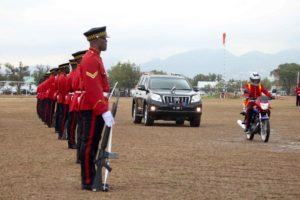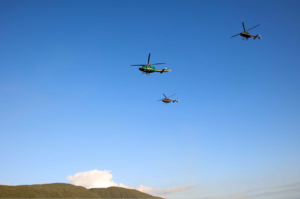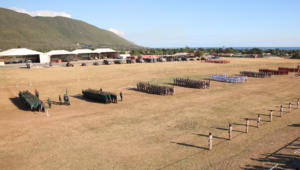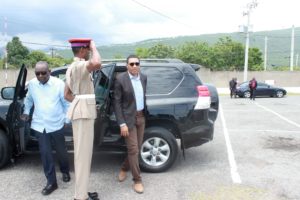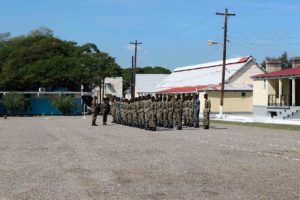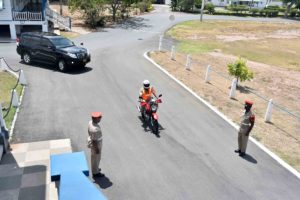Up Park Camp
|
During the seventeenth and eighteenth centuries, British troops posted to the West Indies and in particular to Jamaica suffered great losses as a result of the dreaded disease yellow fever. By the late eighteenth century the mortality rate was nearly 5% of the troops stationed in Jamaica. This led the House of Assembly to pass a resolution permitting construction of suitable barracks for the troops. In 1784, 156 acres of the estate known as Up Park Pen was purchased by the British War Department for 350 Pounds. Lathbury, Curphey and Harman Barracks and the Polo Grounds are the notable large-scale facilities now accommodated on this land. For well over a century little changed, but with the approach of the twentieth century there was great expansion – and then contraction. In 1900, the camp was expanded with the purchase of 257 acres of adjoining land for 3,789 Pounds, 19 Shillings and 6 Pence, upon which now stand the Married Quarters, Briggs Park, the Bustamante Hospital for Children (formally the British Military Hospital) and the National Stadium and Arena. In that same year an additional 85 acres of land was purchased along the eastern side of Mountain View Ave (formerly the Long Mountain Road) for 680 Pounds and used for the construction of a rifle range. Between 1919 and 1922 an additional 112 acres to the north and south of the rifle range was purchased for 1,190 Pounds. Shortly after the first purchase of land in 1784 the barracks at Up Park Camp were destroyed by hurricane, resulting in the construction of temporary barracks with inadequate facilities. Major General (subsequently Field Marshal Sir George) NUGENT, Governor of Jamaica from 1801 – 05, proposed and got approval for the construction of a military hospital and barracks for 1,000 troops. In 1820, Wolmer's Pen was purchased and its well alleviated the severe water problems of the military base. By 1830, and possibly earlier, water was also supplied by means of a pipeline of 8 inch iron pipes down Hope Lane (now Hope Road) from the Hope and Mona sugar estates near Papine. The Camp had changed very little between 1900 and the Second World War (1939 – 45). On the outbreak of war the authorities had to accommodate additional troops and this requirement led to the construction of Harman Barracks (1943 – 44). During World War II a camp was also established for the detention of German prisoners of war. These POWs built the present day Jamaica Officers Club to replace an earlier officers club. In the 1950s Tom Redcam Avenue was built through purchased Camp lands to relieve traffic congestion in Cross Roads. Further land along this road was acquired from the British War Department for the construction of the headquarters of the Jamaica Library Service and the Kingston and St. Andrew Parish Library which were opened in July 1958. Shortly before Jamaica's Independence, the Military Workshop became the Jamaica Military Workshop and moved to its present location within Lathbury Barracks. This made its former facilities available to the Jamaica Constabulary Force which now uses these grounds to house its Transport and Repairs Department. In preparation for Jamaica's hosting of the 1962 Central America and Caribbean Games, 83 acres of land was purchased from the War Department for the construction of the National Stadium. In 1962 Curphey Barracks was built to accommodate the National Reserve. The JDF Air Wing was established in January 1963 and its location in Up Park Camp required the establishing of an airstrip on part of the Polo Grounds. With the withdrawal of United Kingdom Forces in 1962, the British Military Hospital was transformed into a children's hospital (named after the then Prime Minister, Sir Alexander Bustamante). During the 1960s, the then Jamaica Rifle Club (now the Jamaica Rifle Association) acquired a section of Camp land between Mountain View Avenue and the Long Mountain ridge, on which they constructed their headquarters and ranges. This period also saw the disposal of the remainder of the lands east of Mountain View Avenue and the sale of just over 18 acres west of Camp Road. Today Up Park Camp occupies a total of 90 hectares of land and houses all units of the JDF except the JDF Coast Guard, whichever of the regular battalions of the Jamaica Regiment (infantry) is currently based at Moneague Training Camp in central Jamaica and three companies of the Third Battalion Jamaica Regiment (National Reserve) permanently based at Montego Bay, Mandeville and Port Maria. Any location with such a long and diverse history usually has its legends and Up Park Camp is no exception. One of its main entry points is named Duppy (ghost) Gate – and with good enough reason. In the days of the original West India Regiment its sentries at this gate were regularly visited by an officer in period uniform, his sword slapping against his leg. The guard would turn out but as soon as they were ready to report the ghostly officer would. |
|

